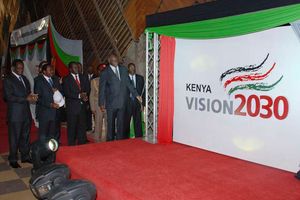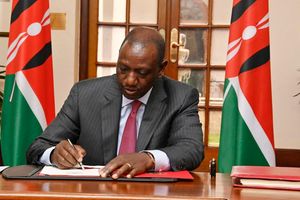
A view of the 35th Ordinary Session of the African Union (AU) Summit in Addis Ababa, on February 5, 2022.
I spent the week in Lusaka at a retreat on operationalising the proposed Africa Credit Rating Agency. The agency is seen as a response to the dissatisfaction of African Union member states with the current credit ratings regime, dominated by three western agencies.
Nor is Africa the first to travel this path. The BRICS (Brazil, Russia, India, China and South Africa) have a similar initiative.
A credit rating is a measure of creditworthiness. It is an estimation of a borrower’s probability of default. How likely is a borrower to default on a loan? A well refined credit rating will take into account expected loss. Does a borrower have the resource base to make good even if a default has occurred?
The consensus view is that African countries have been getting lower ratings than should be the case. They get lower ratings than economic peers in other regions such as Latin America. Argentina for instance, which has defaulted nine times since independence, gets a higher rating than African countries that have never defaulted.
And it costs a bundle. A UNDP study found that collectively African countries pay as much as US$75 billion annually in higher interest rates and opportunity costs, the result of these lopsided credit ratings.
AU member states tasked the Africa Peer Review Mechanism (APRM) to find a solution to this costly state of affairs. APRM started by producing a bi-annual report that tracks sovereign rating actions. Downgrades are regular, upgrades rare.
There is raging debate at both political and technical levels. Why are the ratings lopsided? Is it a residual but persistent perception bias? Are credit rating agencies being deliberately unfair, applying inappropriate methodology, or unable to model informality, they simply misunderstand African economies?
I favour the inappropriate methodology explanation. Too often generic parameters such as debt to GDP ratio or tax to GDP ratio are applied dogmatically, without tapering their use with other related variables. A country with very low or negative real interest rates like Japan, can sustain a very high debt to GDP ratio. Conversely, a country with very high interest rates will struggle even at relatively low debt levels. The ratio, by itself is only half the story.
Corporate ratings take into account country risk. Essentially, a corporate cannot get a higher rating than the country or countries in which she operates. This leads to rather ridiculous conclusions. Since only two African countries – Botswana and Mauritius - have investment grade ratings, African corporates are not seen as investment grade. Yet, there are many great African companies.
One expert suggested that Africa suffers a perception problem much like the secondhand car. As soon it has that label its value diminishes no matter how good a condition the car is in, or how low the mileage is. In this analogy countries receive lower ratings simply on account of being Africa.
In Lusaka, APRM and her partners, Open Societies and United Nations Economic Commission for Africa, had gathered credit rating experts from the continent and further afield. They joined regulators including ministries of finance, capital market authorities and central banks.
The proposed Africa Credit Rating Agency will be a private entity. But experts worry about the current trend of the big three buying out African based credit rating agencies. In 2022, Moody’s acquired GCR, a well-known African based agency.
For better coordination, the credit ratings regulators from various countries have a network to exchange learnings and best practices. The credit rating agencies in attendance in Lusaka – Nigeria’s Augusto & Co, East Africa’s Metropol CRA, CareEdge from Mauritius and Sovereign Africa from South Africa, formed a network for similar purposes.
Back to the secondhand car analogy, how you tell your story is important. The national baseball competition in the US is referred to as the world series! Pompous, but it tells you about their view of themselves.
Similarly, a firm with two offices, one New York and another in London will call themselves global. When an African firm operates in seven African countries, they will still be regarded, and see themselves, as a local or regional firm. Yet the US, western Europe and China can all physically fit in the African continent with room to spare.
To shape our narratives better, is why the AU established the African Audio Visual and Cinema Commission (AACC), a specialised agency. Africa must tell her story, in her own words, and using her own images. Sadly, the host country Kenya, has been lethargic in getting AACC operational.
But why all this focus on European and north American investors? This presumption that there are no investors in Africa is misguided. In Kenya, only a small portion of the budget deficit is financed with commercial debt such as Eurobonds. Debt service on domestic debt is 3.4 times that of foreign debt. That is where the focus should be.
Properly used, credit rating is a key instrument to unlock domestic capital markets. First, it should help regulators speed up approvals of both issuers and issues, bringing down the cost for companies issuing securities. Secondly, because ratings have to be reviewed periodically, it provides a measure of investor protection. Investors can use rating actions to decide whether to stay invested in a particular bond or stock.
Third, credit rating, like its twin credit referencing, provides estimates on default probabilities, and more importantly expected loss. This latter parameter is what risk-based pricing models use.
The conversation continues on 8-9 May in Nairobi, at the Eastern Africa Credit Rating Conference. Driven largely by the private sector, it will deep dive into the use of credit ratings in the domestic capital markets.
@NdirituMuriithi is an economist










